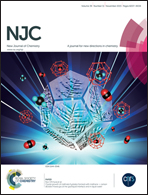Separation and detection of tropane alkaloids in Anisodus tanguticus by capillary electrophoresis-electrochemiluminescence
Abstract
A Ru(bpy)32+-based electrochemiluminescence method coupled with capillary electrophoresis has been developed for the separation and detection of two tropane alkaloids, anisodamine and anisodine, within 7 min with a platinum microelectrode modified with a europium(III)-doped Prussian blue analog film as the working electrode. Under optimized conditions, the ECL intensity was in proportion to the log values of anisodine and anisodamine concentrations in the range 5.0 × 10−6–1.0 × 10−3 mol L−1 (r = 0.9992) for anisodine and 1.0 × 10−6–1.0 × 10−3 mol L−1 (r = 0.9991) for anisodamine, with detection limits of 1.2 × 10−7 mol L−1 for anisodine and 4.3 × 10−8 mol L−1 for anisodamine. The proposed method has been applied to identify and detect the two alkaloids in the different parts (seeds, roots and leaves) of Anisodus tanguticus. The results showed that anisodine existed in all samples, including the seeds, roots and leaves of the plant, and its content was highest in the seeds and lowest in the leaves. However, anisodamine was not found in the samples mentioned above due to the low levels in the plant and maybe the interreaction between anisodamine and other chemicals in the plant. Finally, average recoveries of 98.0–107.0% were obtained.


 Please wait while we load your content...
Please wait while we load your content...